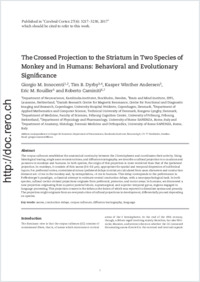The crossed projection to the striatum in two species of monkey and in humans: behavioral and evolutionary significance
- Innocenti, Giorgio M. Department of Neuroscience, Karolinska Institutet, Stockholm, Sweden - Brain and Mind Institute, EPFL, Lausanne, Switzerland
- Dyrby, Tim B. Danish Research Centre for Magnetic Resonance, Centre for Functional and Diagnostic Imaging and Research, Copenhagen University Hospital Hvidovre, Copenhagen, Denmark - Department of Applied Mathematics and Computer Science, Technical University of Denmark, Kongens Lyngby, Denmark
- Andersen, Kasper Winther Danish Research Centre for Magnetic Resonance, Centre for Functional and Diagnostic Imaging and Research, Copenhagen University Hospital Hvidovre, Copenhagen, Denmark
- Rouiller, Eric M. Department of Medicine, Faculty of Sciences, Fribourg Cognition Center, University of Fribourg, Switzerland
- Caminiti, Roberto Department of Physiology and Pharmacology, University of Rome SAPIENZA, Rome, Italy
-
01.06.2017
Published in:
- Cerebral Cortex. - 2017, vol. 27, no. 6, p. 3217–3230
English
The corpus callosum establishes the anatomical continuity between the 2 hemispheres and coordinates their activity. Using histological tracing, single axon reconstructions, and diffusion tractography, we describe a callosal projection to n caudatus and putamen in monkeys and humans. In both species, the origin of this projection is more restricted than that of the ipsilateral projection. In monkeys, it consists of thin axons (0.4–0.6 µm), appropriate for spatial and temporal dispersion of subliminal inputs. For prefrontal cortex, contralateral minus ipsilateral delays to striatum calculated from axon diameters and conduction distance are <2 ms in the monkey and, by extrapolation, <4 ms in humans. This delay corresponds to the performance in Poffenberger's paradigm, a classical attempt to estimate central conduction delays, with a neuropsychological task. In both species, callosal cortico-striatal projections originate from prefrontal, premotor, and motor areas. In humans, we discovered a new projection originating from superior parietal lobule, supramarginal, and superior temporal gyrus, regions engaged in language processing. This projection crosses in the isthmus the lesion of which was reported to dissociate syntax and prosody. The projection might originate from an overproduction of callosal projections in development, differentially pruned depending on species.
- Faculty
- Faculté des sciences et de médecine
- Department
- Département de Médecine
- Language
-
- English
- Classification
- Biological sciences
- License
-
License undefined
- Identifiers
-
- RERO DOC 305112
- DOI 10.1093/cercor/bhw161
- Persistent URL
- https://folia.unifr.ch/unifr/documents/306070
Statistics
Document views: 110
File downloads:
- pdf: 136
